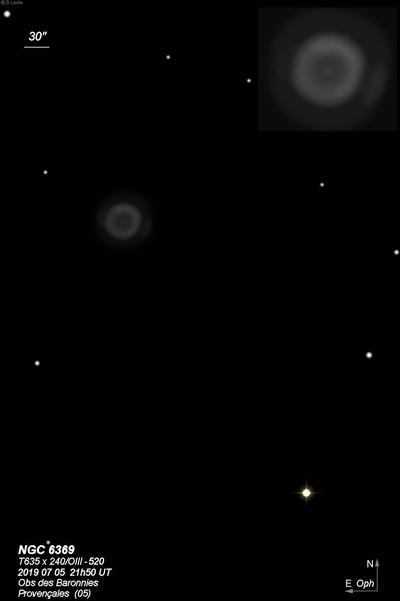Little Ghost Nebula
Little Ghost Nebula

William Herschel discovered NGC 6369 = H IV-11 = h1981 = h3686 on 21 May 1784 (sweep 222) and recorded "a curious round, tolerably defined pB nebula 30 or 40" in diameter." On 26 May 1786 (sweep 566), he called it "pB, R, S, of equal brightness throughout." From the Cape of Good Hope, John Herschel gave a detailed description: "Annular Nebula. Exactly round; pF; 12" diameter; well terminated; but a very little cottony at the edge, and with a decided darkness in the middle; = a * 10m at the most. Few stars in the field [situated in the bowl of the Pipe Nebula!]; a beautiful specimen of the planetary annular class of nebulae." His published sketch is on Plate VI, figure 4. Joseph Turner also sketched the planetary in Sep 1874 using the Great Melbourne Telescope (unpublished plate VII, figure 76).
Based on Crossley photographs at Lick, Curtis (1918) described NGC 6369 as "a regular, nearly round ring, slightly longer in p.a. 120°; much fainter at the eastern end of the major axis and brightest at the north. Diameter 28" center of ring perfectly blank. Quite faint; the ring just shows in 10m on S27. The central star is magn. 16."
John Mallas coined the nickname "Little Ghost" in his Apr/May 1963 article "Visual Atlas of Planetary Nebula-IV", published in the "Review of Popular Astronomy".
300/350mm - 13.1" (8/5/83): use at least 220x to clearly resolve the annularity.
13.1" (7/16/82): beautiful ring at 214x and UHC filter, small, slightly elongated. Visible with direct vision as annular. The north edge of the rim appears brighter at 312x.
400/500mm - 17.5" (6/30/00): at 500x this planetary has a beautiful annular appearance with a 25-30" halo perforated by a 12" dark hole. The northern rim is noticeably brighter with a nearly stellar spot near its center. Located 31' NW of mag 4.8 51 Ophiuchi.
17.5" (6/5/99): bright, beautiful annular planetary at 380x with a well-defined dark central hole. The rim is clearly brighter along the north edge and slightly weaker on the following edge.
17.5" (7/4/86): bright, fairly small, about 30" diameter, green-blue color. Appears as a perfect annular ring at 286x with a 15" central "hole". No central star visible.
600/800mm - 24" (7/14/18): at 500x; gorgeous annular planetary with a prominent 30" ring and a relatively large, dark central hole. The rim is noticeably brighter along an arc running from the west side counterclockwise to the northeast. The rim's surface brightness is quite irregular with at least a couple of sharp brighter spots, the brightest on the northwest rim.
Notes by Steve Gottlieb